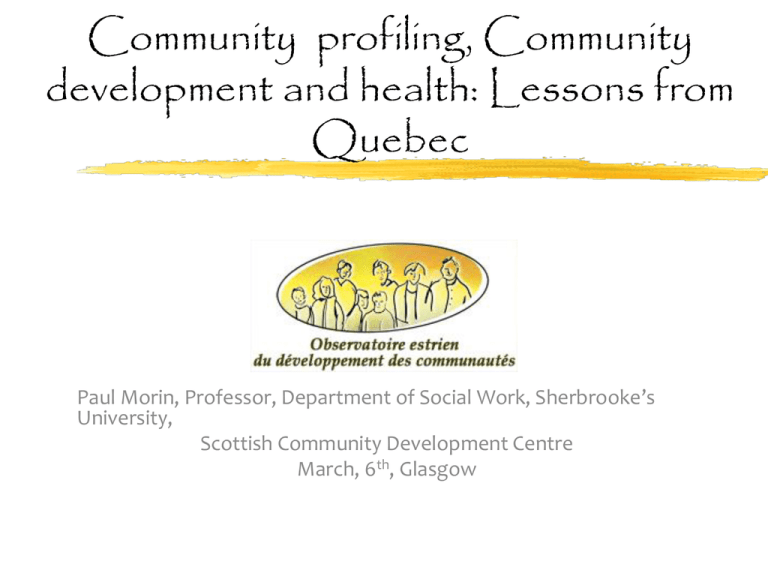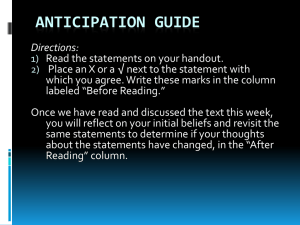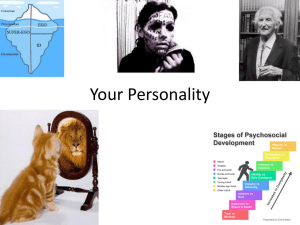this presentation - Community Development Alliance Scotland
advertisement

Community profiling, Community development and health: Lessons from Quebec Paul Morin, Professor, Department of Social Work, Sherbrooke’s University, Scottish Community Development Centre March, 6th, Glasgow Contents Community development in Québec Eastern Townships Community Development Observatory Estrie Community Dashboard: a project for mobilization and joint planning in community development. First experimentation (2009-2011) Contents Development phase (2011- Realistic evaluation (2012-2014) Challenges Community development in Québec Since the early 70’s they are community organizers in the health and social services local public institutions Now called Heath and Social services Center (94 of them) Also community organizers in the third sector (mostly sectorial) Community development in Quebec As stated in Québec’s national public health program, the capacity of people to change their habits and control their situation as regards health and well-being does not only depend on their willpower and capacity to act but also on the conditions of their socio-economic, physical, social, and cultural environment. With regard to this point, community development is one of the leading priorities in regional and local public-health action plans all over Québec. Eastern Townships Community Development Observatory Third sector organisation (2006) Mandate: a partnership between practitioners and academics to create a synergy to promote and develop practice in community development Membership and Composition of the board Shoestring budget A web site : www.oedc.qc.ca Estrie Community Dashboard What is the Eastern Townships Community Dashboard? A tool designed to help orient people, allowing them to take action. A winning combination of statistics and information on the dynamics of local communities, based on census results (2001, 2006 but also 2011, 2016…) and original use of social data. Eastern Townships Community development Observatory Eastern Townships Community development Observatory Estrie Community Dashboard A participative initiative of participants, citizens, elected officials, groups of consultants and researchers. The ability for everyone to be able to detect complex problems that can arise in local communities as well as potential issues that can develop. A tool to support the efforts of local development in progress An acute knowledge of all communities is essential in order to determine what sort of support is needed. The purpose of the dashboard is to compile data on communities and their projects to provide support for the implementation of the developments through : A tool to support the efforts of local development in progress strategic planning; citizen participation; the creation of action plans; the politics of community development; interventions on social inequalities. An interactive and cross-sectoral process L’Observatoire estrien du développement des communautés (OEDC) supports this project, in collaboration with the Direction de la santé publique et de l’évaluation (DSPÉ). At least two representatives from each RMC territory and from Sherbrooke as well as representatives from local organizations form the OECD’s scientific committee. The main goals of this committee are: Estrie Community Dashboard Defining local communities In the spring of 2008, 66 local communities consisting of ± 5 000 people were identified by 73 pivotal members of the Eastern Townships. Choosing quantitative indicators In autumn 2008, the scientific committee chose a series of indicators (age of the population, income, crimes against the person, rate of cancer, housing, etc). (19 indicators = 126 informations) Estrie Community Dashboard Producing Statistics Statistical research is undertaken by the regional public health agency. Acknowledging communities’ potential for development The leaders of each territory invite the citizens and businesses of the local communities to identify their most vital and dynamic areas as well as their zones of vulnerability. Estrie Community Dashboard Producing statistics The first statistics were available on the OEDC website by the summer 2009. Disseminating results Communities and regional authorities will acquaint themselves with the results and discuss how to best transform the information into action. (knowledge transfert) Assessing the process of implementation Evaluations will be made throughout the entire process. Community Potential Appraisal This questionnaire contains 40 statements on life in a local community. • Every group member must complete this questionnaire. • Read each statement while thinking about your local community, and then state whether you agree or disagree with each statement by checking the box which corresponds best to your opinion. • We ask that you answer individually and as spontaneously as possible. You are being asked to give your impression. There are no correct or incorrect answers. • Your answer will remain confidential and will not be disseminated. Only a summary of the discussion will be made public. Eastern Townships Community Scorecard: Action Based on Knowledge 4 Relations in the neighbourhood are good. 5 People have a social life (family, friends, business, etc.) within the community. Not Applicable (N/A) 3 People feel that they can make a difference in their community. Totally agree 2 People do volunteer work. Somewhat agree 1 It is easy to find people who can participate in community projects. Neither agree nor disagree Potential of Individuals Somewhat disagree Statement Totally disagree Eastern Townships Community Scorecard: Action Based on Knowledge 1 2 3 4 5 -— Eastern Townships Community Scorecard: Action Based on Knowledge 9 People enjoy living in this community. 10 People help one another in their daily lives. Not Applicable (N/A) 8 People use public or community services when needed. Totally agree 7 People feel concerned about events in their community. Somewhat agree 6 People have a social life (family, friends, business, etc.) outside the community. Neither agree nor disagree Potential of Individuals Somewhat disagree Statement Totally disagree Eastern Townships Community Scorecard: Action Based on Knowledge 1 2 3 4 5 -— Eastern Townships Community Scorecard: Action Based on Knowledge 15 It is easy to get involved in the community. Not Applicable (N/A) 14 Organizations and associations work together to solve common problems. Totally agree 13 People have access to a variety of organizations and associations within the community. Somewhat agree 12 People frequently use the Internet. Neither agree nor disagree 11 People are interested in local news. Somewhat disagree Community Potential Totally disagree Eastern Townships Community Scorecard: Action Based on Knowledge 1 2 3 4 5 -— Eastern Townships Community Scorecard: Action Based on Knowledge 20 People have access to a variety of modes of transportation for their daily activities. Not Applicable (N/A) 19 There is a variety of local services to respond to everyday needs (corner store, ATM, pharmacy, gas station, etc.). Totally agree 18 Young people participate in athletic and cultural activities. Somewhat agree 17 People visit a public library. Neither agree nor disagree 16 Public institutions are close to citizens (schools, CLSC, municipality, police, etc.). Somewhat disagree Community Potential Totally disagree Eastern Townships Community Scorecard: Action Based on Knowledge 1 2 3 4 5 -— Eastern Townships Community Scorecard: Action Based on Knowledge 25 People take daily measures to preserve the environment (composting, selective collection, etc.). Not Applicable (N/A) 24 People use public or community spaces to meet each other. Totally agree 23 Outdoor public spaces have been laid out. Somewhat agree 22 Buildings and public spaces are attractive. Neither agree nor disagree 21 People care about maintaining their homes and the community in general. Somewhat disagree Environmental Potential Totally disagree Eastern Townships Community Scorecard: Action Based on Knowledge 1 2 3 4 5 -— Eastern Townships Community Scorecard: Action Based on Knowledge 30 People feel safe in the community. 31 Children can play outdoors safely. 1 2 3 4 5 Not Applicable (N/A) 29 There are leaders who can seek grants to fund community projects. Totally agree 28 There are leaders who encourage people to get involved in community projects. Somewhat agree 27 Young people feel that they fit into their community. Neither agree nor disagree 26 The contribution of elders is recognized within the community. Somewhat disagree Collective Potential Totally disagree Eastern Townships Community Scorecard: Action Based on Knowledge -— Eastern Townships Community Scorecard: Action Based on Knowledge 36 People dream of a better future for their community. 1 2 3 4 5 Not Applicable (N/A) 35 People are proud of the patrimony and history of their community. Totally agree 34 People rally when the community faces a trial or hardship. Somewhat agree 33 People want to gather to celebrate events. Neither agree nor disagree 32 People have access to a broad selection of quality and affordable foods in their community or nearby. Somewhat disagree Collective Potential Totally disagree Eastern Townships Community Scorecard: Action Based on Knowledge -- — Eastern Townships Community Scorecard: Action Based on Knowledge Neither agree nor disagree Somewhat agree Totally agree 1 2 3 4 5 Not Applicable (N/A) Somewhat disagree Socio-Economic Potential Totally disagree Eastern Townships Community Scorecard: Action Based on Knowledge -— 37 People have sufficient funds to meet their basic needs (housing, food, clothing, transportation). 38 Significant gaps exist among people living in the community (income, education, etc.). 39 There are poor people living in the community. 40 People in the community benefit from a dynamic economic environment. This appraisal of community potential is directly inspired from: Réal Boisvert (2007). Les indicateurs de développement des communautés. Vers un dispositif national de surveillance, Agence de la santé et des services sociaux de la Mauricie et du Centre du Québec, p. 56-58. Advance knowledge for better actions Observatoire estrien du développement des communautés A quantitative and qualitative tool Comité de mise en oeuvre du Tableau de bord des communautés de l’Estrie Intervenants pivots (MRC) Instances intersectorielles Intervenants pivots (MRC) Instances intersectorielles Intervenants pivots (MRC) Instances intersectorielles Intervenants pivots (MRC) Instances intersectorielles Intervenants pivots (MRC) Instances intersectorielles Instances intersectorielles Comité de suivi Intervenants pivots (Ville) Comité opérationnel ad hoc* Comité opérationnel ad hoc Comité opérationnel ad hoc Comité opérationnel ad hoc Comité opérationnel ad hoc Comité opérationnel ad hoc MRC des Sources MRC du Granit MRC du HautSaint-François MRC du ValSaint-François MRC de Memphrémagog Ville de Sherbrooke Communautés statistiques /vécues Communautés statistiques /vécues Communautés statistiques /vécues Communautés statistiques /vécues Communautés statistiques /vécues Communautés statistiques /vécues A participatory process, intersectoral and to the point Février 2009 − Octobre 2010 An evaluation of the implantation process 5 steps Delimitation of the communities Choice of indicators Discussion on the communities’ potential Validation of description Communities at work Principes d’action Citizen participation Strengthening of empowerment Intersectorality Autonomy of territories 8 pilot communities 3 in Sherbrooke 1 in 5 of the 6 RCM Étapes 4 principles of action PRINCIPES D’ACTION ÉTAPES TB Concertation/ PRINCIPES Participation D’ACTIONAutonomie des Autonomie des ÉTAPES POUR ÉVALUATION intersectorialité des acteurs milieux milieux Augmentation TB Concertation/ PRINCIPES Participation Autonomie des D’ACTION du pouvoir ÉTAPES Étape 1 : POUR ÉVALUATION intersectorialité des acteurs milieux d’agir TB Délimitation des Concertation/ Participation PRINCIPES D’ACTION Autonomie des Autonomie des Étapecommunautés 1: POUR ÉVALUATION intersectorialité des acteurs milieux Renforcement Participation Concertationmilieux ÉTAPES Délimitation des Autonomie des locales du pouvoir intersectorielle Étape 1communautés : citoyenne Étape 2 : milieux d’agir Délimitation des localesChoix des communautés Étape 2indicateurs : Étape 1 locales Choix des statistiques et les Délimitation des Étape 2 indicateurs : analyses communautés Choixstatistiques des et les 3 : Étape indicateursanalyses Groupes de statistiques etÉtape les discussion 3: Étape 2 de de Choix desanalysesGroupes l’appréciation du : de de la indicateursÉtape 3discussion potentiel Groupes de l’appréciation du communauté de potentiel de la 4 : Étape 3discussion Étape l’appréciation duPrésentation des Discussion sur le communauté deÉtape la portraits 4 : dans les potentielpotentiel des communauté Présentation des communautés communautés Étapeportraits 4: dans les Étape 5 : Présentation des communautés Étape 4 portraits dans lesMise en action des Validation des Étape 5 : communautés communautés portraits Mise en action des Étape 5communautés : Mise en action des Étape 5 communautés Mise en action des communautés The TBCE can be linked to: Place-based policy spaces and strategies Local knowledge for community-based planning and Collaborative community building First experimentation (2009-2011) Intersectoral concertation Creation and consolidation of spaces of concertation : the most important effect of the TB dashboard Intersectoral process demanding and complex which requires the development of a common vision of the process The co-construction of a « territorial intelligence » (RCM, communities) A long term commitment of partners to this concerted action First experimentation (2009-2011) Appropriation By the regional stakeholders: They had to reflect on the process and construct tools By the key territorial persons: Understand themselves the process Staff movement Partial vision at the start without always understanding the finality First experimentation (2009-2011) To adapt the process in their territory To have the partners adhesion: - by the key territorial persons (with one-off or longer term involvement) - by the citizens during the appreciation of the potential First experimentation (2009-2011) Citizen participation A difficult principle to operationalise for the practitioners Citizens especially present at the stage of the appreciation of the potential of the communities The necessity emerged: Of reinforcing the consensus in the territories Of being equipped with tools and mechanisms to be able to make things differently Development phase (2011 The TB dashboard is completed (first phase) At the end of 2013, 27 of Sherbrooke’s 33 communities will have completed the process TB is utilized by third sector organisations for planning and demanding subventions TB has been utilized for determining the allocation of a regional fund on poverty and social exclusion Realistic evaluation (2012-2014) funded by the CIHR The current research aims to evaluate TBCE’s approach in terms of its position in response to the question: What is the potential impact of the TBCE’s strategies on social determinants of health (SDH)? Realistic evaluation (2012-2014) funded by the CIHR The approach of the TBCE has a substantial impact in assisting residents to take ownership of the reality of their devitalized community (which is not easy to accept) and to guide them in their first steps towards mobilization in order to take action on this reality. Realistic evaluation (2012-2014) funded by the CIHR Dedicated and visionary leaders Participation: structured, concerted and inclusive Joined-up action Concrete and innovative actions Access to ressources, with support Realistic evaluation (2012-2014) funded by the CIHR (Sherbrooke) Adhesion to TBCE of public institutions and third sector organizations as being perceived in synergy with their mandate Support and expertise of key human resources, mainly from public institutions Recognition that for acting on the quality of life, the action must be intersectoral and having a dynamic of partnership The staged implementation of TBCE has produced an appropriation of the process and its concrete potential Realistic evaluation (2012-2014) funded by the CIHR Challenges at the municipal level: Find the funds that will permit the concretisation of the municipality orientation in community development A better articulation between the diverse responsibilities of the key stakeholders Realistic evaluation (2012-2014) funded by the CIHR Challenges at the municipal level: Being able to start community development in communities very much disadvantaged Consolidate community development that is already in place Develop the reflex of using the TBCE Realistic evaluation (2012-2014) funded by the CIHR Mont-Bellevue’s district example: Leadership of the district and of the councillors for the TBCE process A territorial third sector organization is using the TBCE in conjunction with its mobilization strategy Appropriation of the intersectoral dimension by key stakeholders Realistic evaluation (2012-2014) funded by the CIHR (Mont-Bellevue) Realistic evaluation (2012-2014) funded by the CIHR Example of a project in Mont-Bellevue: the primary school project: The community organizers have used the TBCE as the tool for organizing the information: Realistic evaluation (2012-2014) funded by the CIHR The level of schooling is way under the average One household of three is under the annual poor income level 23.4 % of children are living in a household under the annual poor income level An evolving partnership between the Health and Social services center and the School board Final Challenges Consolidate the partnership between communities, academics and other stakeholders Junction with the economic world Thanks for your attention Paul.morin@usherbrooke.ca










